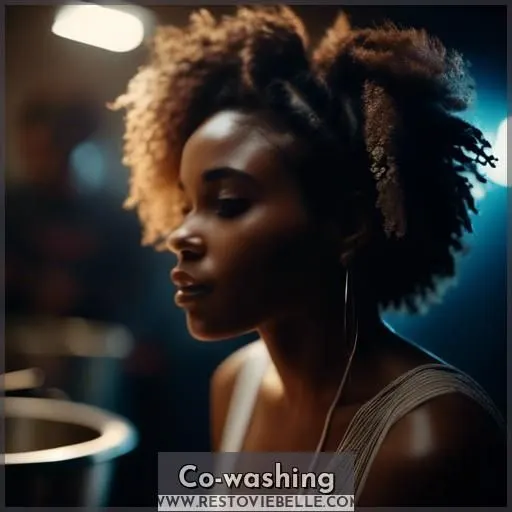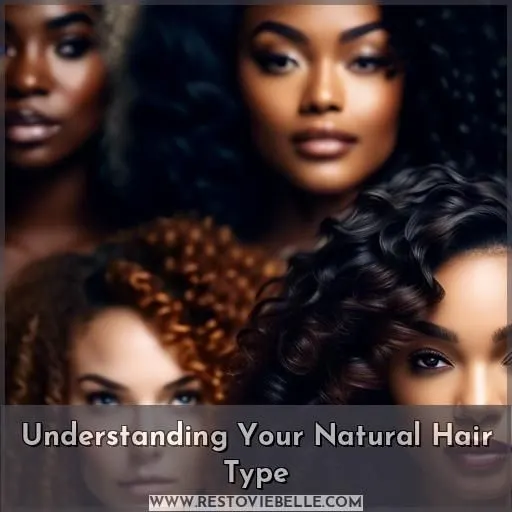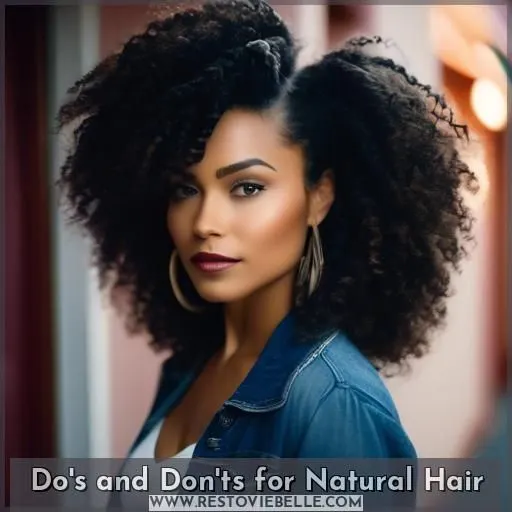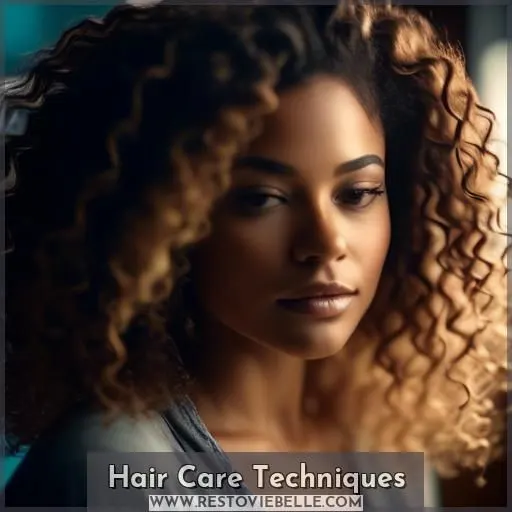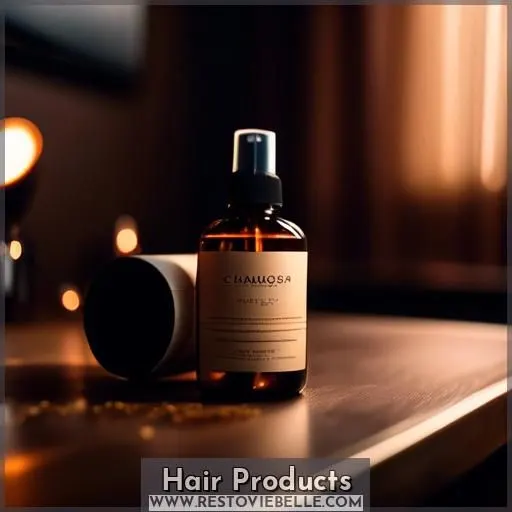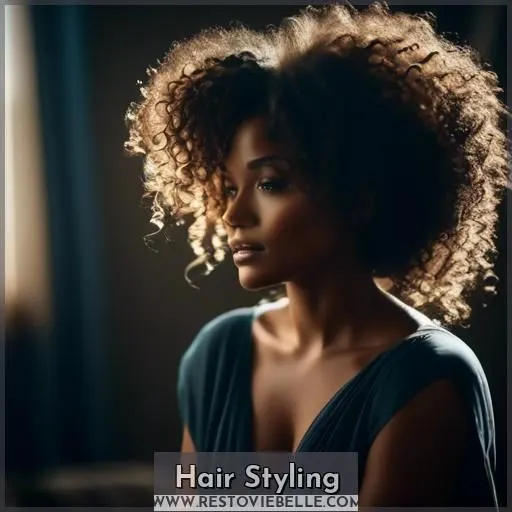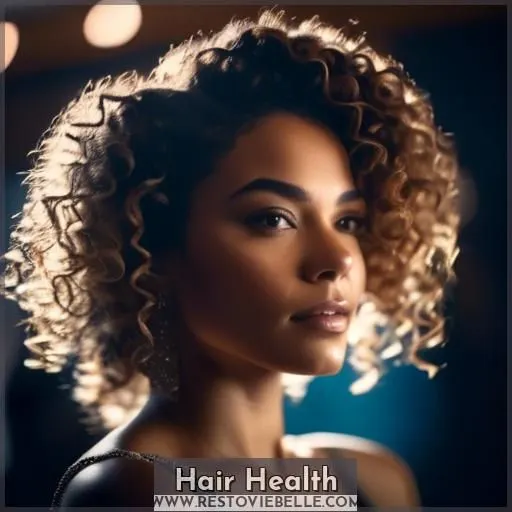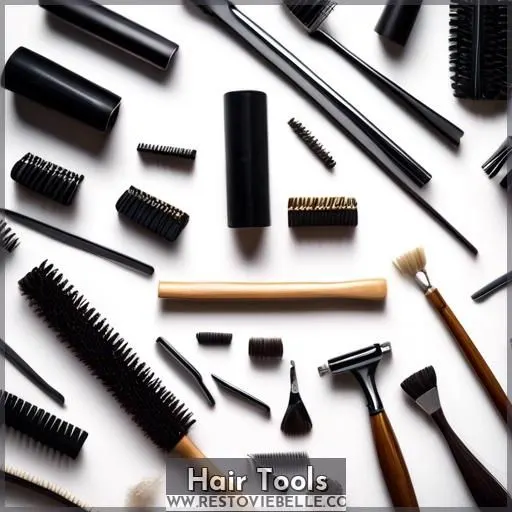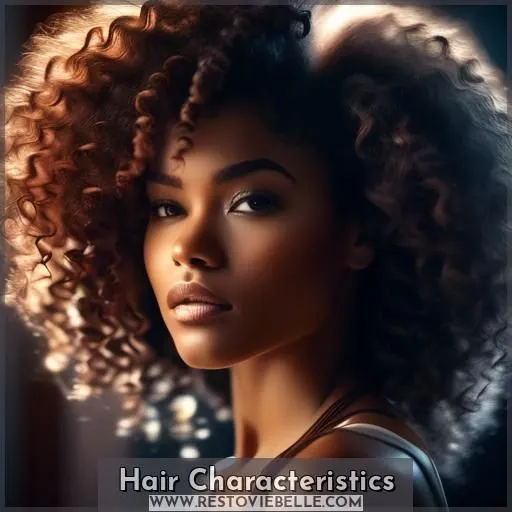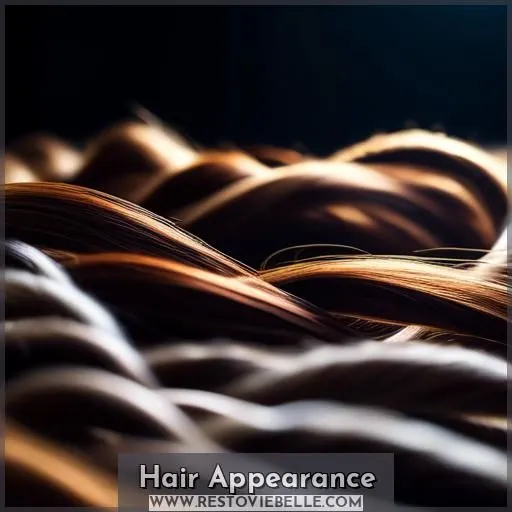This site is supported by our readers. We may earn a commission, at no cost to you, if you purchase through links.
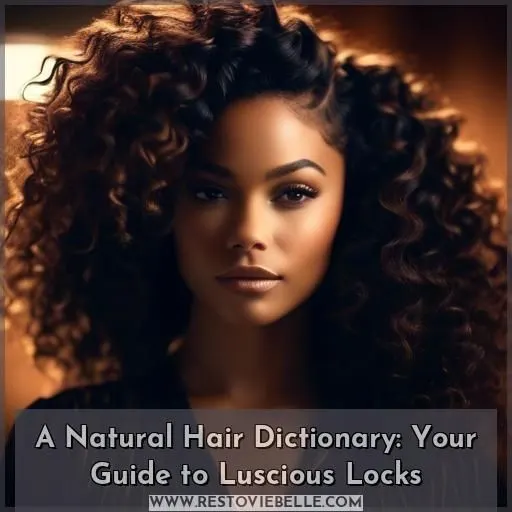
Your natural hair is unique and deserves the proper care. This natural hair dictionary will guide you through key concepts like co-washing, detangling, and protective styling.
Understand your hair type – be it wavy, curly or coily – to tailor your regimen. Discover the do’s and don’ts, from texturing to heat styling, plus essential hair care techniques.
Familiarize yourself with a wealth of hair products, from oils to shampoos, and master styling methods like the Bantu knot-out.
With this extensive natural hair dictionary, you’ll be on your way to cultivating luscious, healthy locks. Keep reading to uncover a wealth of hair expertise.
Table Of Contents
Key Takeaways
- Understanding your hair type is crucial for appropriate hair care.
- Co-washing is a technique that involves using conditioner to cleanse your hair instead of shampoo.
- Detangling is an essential aspect of preserving your hair’s well-being and aesthetic.
- Protective styling is a secret arsenal against damage, serving as a fortress while your hair flourishes in tranquility.
Co-washing
Co-washing is the practice of using conditioner instead of shampoo to cleanse and moisturize your natural hair. Detangle your strands with a wide-tooth comb, then try protective styling techniques like wash-and-go to show off your luscious locks.
Detangle
Detangling your natural hair is an essential aspect of preserving its well-being and aesthetic. Here are some pointers on how to untangle your hair efficiently:
- Prepare your hair: Commence by wetting your hair and applying a liberal amount of conditioner or a detangling spray. Seek out products specifically tailored for your hair type, such as curly, wavy, kinky, or straight hair. These products lessen friction and make the detangling process more manageable.
- Divide your hair: Section your hair into smaller sections using hair clips or ties. This aids you in focusing on one section at a time, preventing unnecessary tugging and potential breakage.
- Use the right tools: A wide-toothed comb or a detangling brush is ideal for natural hair. These tools can separate clumps and undo knots without excessive tugging and potential breakage.
- Start at the ends: Begin detangling from the ends of your hair and work your way up to the roots. Use short strokes to minimize pulling.
- Detangle with care: Exercise patience and gentleness when detangling. Avoid forcefully ripping through knots, as this can cause breakage and damage.
- Moisturize and protect: After detangling, apply a leave-in conditioner or a moisturizing cream to hydrate and nourish your hair. Use natural oils or hair serums for extra protection and enhanced shine.
- Styling: Consider adopting a protective style, such as braids or twists, to assist in keeping it tangle-free and reducing new knots.
Wide Tooth Comb
In the realm of detangling natural hair, employing a wide tooth comb revolutionizes the game. This delicate implement aids in preventing breakage and harm, particularly when coupled with co-washing methods.
For optimal outcomes, opt for a comb tailored specifically for natural hair textures. Apply it while your hair is still moist.
Do not overlook the utility of detangling sprays and oils, which will facilitate a smoother process.
Bear in mind, the essence lies in patience and gentleness, akin to a master craftsman meticulously crafting a prized artwork.
Protective Styling
After detangling with a wide-tooth comb, embark on a journey of protective styling.
It’s your secret arsenal against damage, serving as a fortress while your hair flourishes in tranquility.
Envision it as a sanctuary for your scalp’s well-being and hair’s growth.
Be it a wash and go, twist-out, or two-strand twists, protective styles preserve second-day hair with effortless elegance.
Natural
Co-washing is a technique that involves using conditioner to cleanse your hair instead of shampoo. It’s particularly beneficial for those with curly or coily hair types, as it helps to define curls, reduce frizz, and promote scalp health. When co-washing, it’s vital to choose a sulfate-free, moisturizing conditioner that suits your hair type. For example, individuals with fine strands should opt for volumizing co-washes, while those with thick, dense hair can benefit from co-washes with detangling properties.
To co-wash your hair, start by wetting it thoroughly with warm water. Then, apply the conditioner to your palms and massage it into your scalp, adding water as needed to create a lather. Rinse the conditioner out, leaving a little residue for added moisture. You can also use a wide tooth comb to detangle your hair during this process.
Co-washing can save time, as some co-washes can replace the need for multiple hair products. It’s also gentle on hair, helping to maintain its natural moisture levels and aiding in detangling. However, it’s imperative to be aware that co-washing may not effectively cleanse hair as thoroughly as shampoo, so clarifying shampoos may still be necessary for some individuals.
Incorporating co-washing into your hair care routine can help protect your hair’s natural oils, keep your scalp hydrated, and potentially reduce frizz. It’s a versatile technique that can be adjusted to different hair types, ensuring that everyone can enjoy the benefits of this gentle cleansing method.
Wash and Go
The wash and go is a simple yet effective natural hair technique.
Start by co-washing with a gentle, moisturizing conditioner to cleanse and hydrate your strands.
Apply a leave-in conditioner or curl cream.
Let your hair air-dry for a frizz-free, defined look.
Finish with a light oil to seal in moisture and enhance shine.
Embrace your natural texture with this low-maintenance style!
Understanding Your Natural Hair Type
Understanding your natural hair type is essential for appropriate hair care. The three main curly hair types are Type 2 (wavy), Type 3 (curly), and Type 4 (coily/kinky), each with distinct features that necessitate specific techniques and products to maintain healthy and manageable hair; protective styles are also indispensable for reducing manipulation and preventing damage.
Type 2
Unveiling your innate hair texture is paramount for preserving vibrant tresses.
Type 2 hair, colloquially known as wavy hair, exhibits a subtle S-shaped configuration.
To amplify its inherent allure, prioritize moisture retention. Utilize the accordion technique to distribute products evenly on day-old hair. Detangle dense hair with a wide-toothed comb and embrace protective hairstyles.
For styling flexibility, experiment with banding or braid-outs. Incorporate heat protectants and introduce slip into your regimen.
Celebrate your mixed curly hair and consider a significant trim for a refreshing transformation.
Type 3
Type 3 hair, also known as curly hair, comes in three subtypes: 3A, 3B, and 3C.
Type 3A hair has loose, large curls that resemble ringlets.
Type 3B hair has more defined curls that may resemble S-shaped waves.
Type 3C hair is highly coiled and often appears like kinky hair.
To maintain and define your Type 3 hair, focus on moisturizing and using products that provide hold.
Consider changing from chemicals to natural hair by incorporating shea butter, aloe vera, and other natural hair care techniques mentioned in the Natural Hair Dictionary.
Type 4
Shifting from the looser curls of Type 3, Type 4 texture stands out with its tightly coiled virgin hair.
This texture boasts high hair density and varying hair porosity, requiring adept styling techniques to maintain hair growth and health.
Embrace your natural hairstyles, reveling in chemical-free hair’s power.
Protective Styles
Protective styles are your natural hair’s best friend.
They shield your curls from the harsh effects of chemical treatments and the damaging heat of styling tools.
By embracing protective styles, you’re giving your hair a break from manipulation, reducing breakage, and promoting hair growth.
Whether it’s braids, wigs, or twists, these styles minimize stress on your natural hair, helping it thrive in its most authentic state.
Do’s and Don’ts for Natural Hair
You should be cautious with texturing and heat styling techniques, as they can cause significant damage to your natural hair. Excessive use of chemical treatments, straighteners, or curling irons can lead to dryness, breakage, and overall hair health deterioration.
Texturing
Essential aspect of natural hair care is texturing. To improve your hair’s texture, select appropriate products and styling techniques. Protective hairstyles are highly beneficial, as they reduce damage from heat. Keep in mind, applying less product is often more effective. Additionally, it’s important to take into account your hair type and its individual requirements.
Heat Styling
Heat styling can be a double-edged sword for natural hair. On one hand, it can help achieve desired styles and tame unruly curls. On the other hand, excessive heat exposure can lead to heat damage, which can manifest in various ways such as frizziness, split ends, and poor color retention. To minimize the risk of heat damage, it’s essential to follow these guidelines:
- Prep your hair: Begin by cleansing your hair with an appropriate shampoo and conditioner. Towel-dry your hair, leaving it damp for extra lubrication. Apply a heat protectant spray to coat your hair before styling.
- Choose the right temperature: Adjust the heat settings on your styling tool to a temperature that suits your hair type. For fine natural hair, aim for mid-high 300°F, while for medium to coarse natural hair, high 300-low 400°F is recommended. Avoid temperatures higher than 450°F, as this can lead to severe heat damage.
- Maintain a moisture-protein balance: Make sure your haircare routine includes both moisture and protein treatments. Deep conditioning treatments, leave-in conditioners, and oils can help maintain a healthy balance between moisture and protein.
- Limit heat exposure: Try to minimize the frequency of heat styling and opt for more natural styles when possible. If you must use heat, use it sparingly and intermittently.
- Understand your hair porosity: Highly porous hair is more susceptible to heat damage, so be extra cautious when styling.
Hair Care Techniques
The accordion method involves applying products to your second-day hair in a specific pattern, helping to revive and redefine your curls. If you’re experiencing alopecia, or hair loss due to improper styling or health problems, apple cider vinegar can act as a clarifying and cuticle-sealing treatment to promote hair health.
Accordion Method
The Accordion Method is a hair care technique that involves applying products to second-day hair. This method aids in revitalizing hair and promoting moisture retention.
By employing this technique, you can ensure that your hair remains hydrated and healthy, even on days when you don’t wash it. It’s a straightforward yet effective way to preserve your hair’s natural luster and bounce.
Alopecia
Alopecia, a condition characterized by hair loss, can be caused by various factors, including genetics, stress, and autoimmune disorders.
Symptoms include patchy hair loss, itching, and burning at the affected site.
Diagnosis typically involves a physical examination and, in some cases, a skin biopsy.
Treatment options include steroids, immunotherapy, and, more recently, JAK inhibitors such as baricitinib and ritlecitinib, which have shown promising results in clinical trials.
Prevention strategies include maintaining a healthy scalp, avoiding tight hairstyles, and limiting the use of heat styling tools.
Apple Cider Vinegar
Reveal the key to luscious locks with apple cider vinegar, your hair’s newfound ally. This formidable ingredient isn’t confined to salads; it’s a revolutionary force in your hair care regimen.
- Apple cider vinegar rinse restores your hair’s pH equilibrium, bestowing it with silkiness and radiance.
- Apple cider vinegar hair mask provides profound nourishment, subduing frizz and preventing breakage.
- Apple cider vinegar scalp treatment battles dandruff and alleviates irritation.
Immerse yourself in the realm of apple cider vinegar’s virtues and witness your hair’s metamorphosis.
Hair Products
You’ll want to embrace natural oils and botanicals that nourish and protect your strands. Amla oil bolsters hair health, apricot oil seals the cuticles for shine, argan oil prevents frizz during air-drying, aritha soap nuts cleanse oily scalps, and avocado oil deeply conditions parched tresses.
Amla Oil
Amla oil, derived from the Indian gooseberry, is a popular ingredient in hair care products, particularly in Indian hair oils. It’s known for its anti-inflammatory, moisturizing, and oil-regulating properties, making it beneficial for those with oily and itchy scalps but dry and brittle ends. Amla oil is rich in vitamin C, antioxidants, minerals, and amino acids, which promote a healthy scalp, strengthen hair follicles, and stimulate healthy new growth.
Amla oil has been found to inhibit 5-alpha reductase, an enzyme that contributes to male pattern baldness. It also contains tannins, which protect hair from photo-damage and heat damage, and vitamin C, which helps clarify the scalp and remove product buildup.
To use amla oil, you can blend it with other oils like coconut oil or sesame oil, or infuse it using a double boiler method. Amla oil can be applied topically to the scalp and hair, and it’s also used in hair packs for deep conditioning and scalp exfoliation.
Apricot Oil
Apricot oil is a fantastic addition to your hair care routine. It seals hair cuticles, adds shine, and provides hair with moisture. Here are five ways to incorporate apricot oil into your hair care:
- Pre-shampoo treatment: Apply apricot oil to your hair before shampooing to lock in moisture.
- Conditioner booster: Add a few drops of apricot oil to your conditioner for an extra boost of shine and moisture.
- Leave-in treatment: Apply apricot oil to your hair after washing and let it sit for a few hours before rinsing.
- Hot oil treatment: Warm up apricot oil and apply it to your hair for a deep conditioning treatment.
- End of the day: Apply apricot oil to your hair before going to bed to lock in moisture and protect your hair from environmental damage.
Argan Oil
Argan oil, a precious elixir from the argan tree, is a must-have for your hair and skin care routine.
Known for its numerous benefits, it can be used as a pre-shampoo treatment, as a styling oil, or even as a facial moisturizer.
It is rich in fatty acids and antioxidants, making it an excellent choice for those seeking to improve the health and appearance of their locks.
While it is a bit pricier than other oils, the value it brings to your routine is worth the investment.
Aritha Soap Nuts
Aritha Soap Nuts, also known as Soapnuts, are a natural ingredient that has been used for centuries in Ayurvedic medicine for hair cleansing and nourishment. These small, dried berries contain saponins, which act as natural foaming agents and provide a deep cleansing effect for your hair and scalp. Here’s how you can incorporate Aritha Soap Nuts into your hair care routine:
- Deep Cleansing: Aritha Soap Nuts can be used to create a natural shampoo by boiling the dried berries in water to release the saponins. This tea can then be used as a hair wash or mild cleanser.
- Oily Scalp: Aritha Soap Nuts have natural antifungal and antibacterial properties, which may help with dandruff and scalp infections.
- Natural Shampoo: You can purchase organic shampoo bars made with Aritha Soap Nuts, which provide a gentle, deep cleanse without stripping the hair of its natural oils.
- Sustainability: Aritha Soap Nuts are biodegradable, chemical-free, and gentle on the skin and scalp. They’re also sustainable, as the inner seed can be planted to create new trees.
Avocado Oil
Avocado oil is a must-have in your hair care routine.
This nourishing oil is rich in vitamins, minerals, and healthy fats that deep condition your hair, promoting growth and maintaining hair health.
It’s perfect for those with dry, damaged hair, as it penetrates the hair shaft, sealing the cuticle and preventing further damage.
Embrace the power of avocado oil and watch your luscious locks thrive.
Hair Styling
For those embracing their natural curls, the bantu knot-out technique offers a way to enhance definition by unraveling bantu knots, while banding allows for stretching the hair without heat. Braid-outs, achieved by removing braids, create a distinctive wavy pattern that can be combined with bantu knots for added versatility in styling options.
Bantu Knot-Out
Bantu Knot-Out is a hairstyling technique that involves creating Bantu knots and then unraveling them to reveal defined, springy curls. This style is perfect for those with natural hair, as it allows for maximum curl definition without the use of heat or chemicals. Here’s how to achieve a stunning Bantu Knot-Out:
- Start with clean, damp hair: Begin by washing and conditioning your hair, then detangle it using a wide-tooth comb. Apply a leave-in conditioner or styling product to help define your curls.
- Section your hair: Divide your hair into small sections, using a rat-tail comb to create a parting. This will make it easier to work with each section individually.
- Create Bantu knots: Take a small section of hair and twist it into a two-strand twist. Then, roll the twisted hair around its base into a knot, securing it with a bobby pin or hair tie. Repeat this process for each section of your hair, making sure to keep the knots neat and consistent in size.
- Let the knots set: Allow the Bantu knots to set overnight or for at least 8 hours. This will allow the curls to fully develop and set in place.
- Unravel the knots: Gently unravel the Bantu knots, starting from the bottom and working your way up. Use your fingers to separate the curls and fluff them out for added volume.
- Finish with a styling product: Apply a lightweight styling product, such as a curl cream or defining gel, to help hold the curls in place and add shine.
- Enjoy your Bantu Knot-Out: Your natural curls should now be defined, bouncy, and full of life. You can wear them as is or style them into a updo or other protective hairstyle for added longevity.
Bantu Knots
Bantu knots are a popular hairstyle for those with natural hair, especially for those with Type 2 and Type 3 hair. To create Bantu knots, follow these steps:
- Wash and condition your hair.
- Apply a styling product.
- Section your hair into small sections.
- Twist each section into a knot and secure with a hairpin or band.
Bantu knot styles vary in size and duration. Smaller knots last longer but may require more time to create. Larger knots are easier to do but may not last as long. The results can be stunning, showcasing your natural curls and texture.
Banding
Banding serves multiple purposes beyond merely keeping your hair out of your face; it’s a strategic maneuver for fostering hair growth and enhancing its texture. By wrapping sections of your hair with bands, you’re not merely preventing hair damage but also promoting volume. Consider it as a customized hair workout, shaping your locks into a masterpiece of resilience and fullness.
Braid-Out
Braid-Out is a styling method that involves braiding your hair and then unraveling it to reveal defined curls.
This technique is perfect for those with Type 2, 3, and 4 hair types, as it helps to enhance natural curl patterns.
Braid-Out is also a protective hairstyle that minimizes stress on your hair, making it a great choice for those practicing natural hair care.
To achieve the best results, use a wide-tooth comb for detangling and co-wash with conditioners instead of shampoos.
Experiment with different braid techniques and styling methods to find what works best for your hair type.
Hair Health
Hair breakage and loss can be distressing, but understanding the root causes is essential to promoting healthy hair growth. Factors like excessive heat styling, tight hairstyles, chemical treatments, nutrient deficiencies, hormonal imbalances, and underlying medical conditions can contribute to breakage and shedding, so identifying and addressing these issues is critical for restoring your hair’s strength and health.
Breakage
Hair breakage can feel like a battle against your own tresses, but with the right strategy, you can emerge victorious. Consider this your battle plan:
- Identify hair breakage causes: over-styling, harsh chemicals, or heat damage.
- Embrace breakage prevention: gentle handling and protective styles.
- Invest in breakage repair: deep conditioning treatments.
- Choose breakage products: look for protein-rich formulas to fortify strands.
Hair Loss
Regarding hair health, hair loss is a prevalent issue.
Comprehending the causes, symptoms, and remedies can aid you in preventing and treating hair loss efficiently.
Hair loss can stem from various factors such as heredity, stress, nutrition, and styling techniques.
It’s crucial to ascertain the underlying cause to determine the most appropriate treatment or preventive measure.
Some effective hair loss prevention methods include adhering to a healthy diet, implementing proper hair care, and refraining from tight hairstyles.
Hair Growth
To achieve the best hair growth possible, it’s important to know what affects it. Here are four key points to keep in mind:
- Healthy Diet: A balanced diet full of vitamins and minerals, like B vitamins, iron, zinc, iodine, and silica, helps hair grow healthy.
- Exercise: Regular exercise makes more blood flow to the scalp, which helps hair grow better by giving it more oxygen and nutrients.
- Avoid Stress: High stress levels can cause hair loss by putting more follicles into the resting phase, which slows down hair growth.
- Use the Right Products: Choose organic and herbal shampoos that help hair grow healthy, and avoid products that can damage hair and cause breakage and hair loss.
Hair Tools
A microfiber towel is a must-have for gently drying natural hair without causing excessive frizz or disrupting the curl pattern. For those with mid-back length or longer hair, using the right tools like a seamless wide-tooth comb can help detangle strands and minimize breakage during the styling process.
Microfibre Towel
Embrace the power of microfibre towels for your luscious locks. These towels, made from ultra-soft fibres, reduce frizz and gently absorb moisture, ensuring your hair dries without damage. Compact and lightweight, they’re perfect for travel. Say goodbye to traditional towels that cause breakage and hello to a friendlier, more efficient way to dry your hair.
Mid Back Length
Mid back length hair care requires a balance between maintaining the length and preventing damage. Here’s a quick guide:
- Styling: Opt for protective styles like braids or wigs to minimize stress.
- Products: Use lightweight oils for moisture, like argan or almond oil.
- Tools: A microfibre towel helps reduce breakage during drying.
- Health: Regular trims and a balanced diet can promote growth.
Hair Characteristics
Your hair’s thickness and coarseness play a key role in determining the most effective haircare routines. Thicker, coarser hair textures typically require more detangling and moisturizing to maintain manageability and prevent breakage.
Thickness
To fully comprehend the bountiful tresses you’ve been endowed with, it’s crucial to grasp the notion of hair density. Hair density denotes the quantity of individual strands per square inch on your scalp, which plays a pivotal role in the overall aesthetic of your hair. It’s not a barometer of quality, but a distinct feature that can be categorized into three primary types: scant, moderate, and abundant.
Scant hair density, also known as fine hair, exhibits a thin and delicate appearance, requiring more styling aids to retain its form. Moderate hair density, or regular hair, is neither thick nor thin and typically necessitates minimal styling products. Abundant hair density, conversely, manifests as thick and voluminous throughout its length, with substantial body.
To ascertain your hair density, you could attempt the ponytail test. Gather your dry hair into a ponytail and measure the girth of the loop with a ruler. If it falls short of 2 inches, you probably have scant hair density. A measurement between 2-3 inches suggests moderate hair density, while four inches or more indicates abundant hair density.
Comprehending your hair density can assist you in selecting the most natural-looking hair extensions or wigs, and also provides valuable information for your experiences with hair coloring and chemical treatments. Moreover, it can guide your optimal haircare routine, offering insights into product selection and styling techniques that are most compatible with your hair type.
Coarseness
Coarseness is a vital aspect of hair texture. It pertains to the thickness and density of each hair strand. Coarse hair often exhibits a thicker and more resilient nature compared to fine hair. Here are three ways to appreciate your coarse hair:
- Embrace the Thickness: Coarse hair possesses a natural fullness that can be accentuated with appropriate styling techniques.
- Select the Right Products: Consider volumizing shampoos and conditioners to amplify volume and control.
- Explore Styles: Experiment with protective styles such as braids or wigs to minimize breakage and highlight your hair’s inherent beauty.
Hair Appearance
Straight, wavy, curly, or coily – your hair’s natural appearance is determined by the shape of your hair follicles. Embrace your hair’s unique texture and let it shine in all its glory!
Straight
Straight hair is often admired for its sleekness and versatility. However, maintaining its natural beauty and health requires a specific hair care routine designed to suit the hair type. Here are some essential steps to include in your straight hair care routine:
- Shampooing: Use a gentle shampoo formulated for straight hair, focusing on cleansing the scalp and roots while avoiding overwashing to prevent stripping natural oils.
- Conditioning: Apply a lightweight conditioner to the mid-lengths and ends of your hair, letting it sit for a few minutes before rinsing thoroughly with cool water.
- Drying: Gently squeeze out excess water using a microfiber towel or an old T-shirt, avoiding vigorous rubbing that can cause frizz. Allow your hair to air dry whenever possible to minimize heat damage, or use a heat protectant spray and set the dryer to the lowest heat setting if blow-drying.
- Brushing: Use a wide-tooth comb or a brush with soft bristles to detangle your hair gently, starting from the ends and working your way up to prevent breakage.
- Styling: Opt for lightweight styling products to avoid weighing down your straight hair, and avoid excessive heat styling with flat irons and curling irons. Choose hairstyles that don’t require excessive pulling or tension, as it can lead to breakage.
- Trimming: Schedule regular trims every 6-8 weeks to remove split ends and maintain a healthy appearance.
- Protection: Shield your hair from the sun’s harmful UV rays by wearing a hat or using a leave-in conditioner with UV protection. Minimize exposure to chlorine and saltwater, or rinse your hair thoroughly after swimming to remove any residual chemicals.
- Overnight Care: Consider sleeping on a silk or satin pillowcase or use a silk/satin bonnet or scarf to prevent frizz and tangles. Use hair-friendly accessories like scrunchies or silk/satin hair ties to minimize damage.
Incorporating these steps into your hair care routine will help maintain the smooth, manageable, and lustrous appearance of your straight hair while keeping it healthy and vibrant.
Wavy
Wavy hair, with its gentle curves and bends, strikes the perfect balance between straight and curly. It’s versatile, often embodying the freedom of the ocean waves. To keep those waves looking their best, consider these points:
- Hair products designed for moisture without weighing down your waves.
- Care techniques that enhance your natural texture.
- Styling methods that promote hair health and prevent frizz.
Curly
Curly hair is a unique and beautiful trait, but it can be challenging to manage. To achieve defined curls, you can try the Knot method, Finger coiling, or Gel casting. The Knot method involves using a gel or cream to create a cast around your curls while they dry, helping to define and hold the curls in place. Finger coiling is a technique where you twist small sections of your hair around your finger to create a spiral, which can help define and separate curls. Gel casting is the process of applying a gel to your hair while it’s still wet, allowing it to dry with the curls in place, and then scrunching out the crunch once it’s dry to reveal soft, defined curls.
To enhance your curls, you can use curl creams. These products help to define and moisturize your curls, preventing frizz and flyaways. Look for curl creams that contain ingredients like aloe vera, shea butter, and coconut oil, which can help to hydrate and nourish your curls. Remember to apply these products to damp hair and scrunch to distribute evenly.
When styling your curls, consider using a braid-out or twist-out technique. These methods involve braiding or twisting your hair into small sections, allowing it to dry, and then unraveling the braids or twists to reveal defined curls. You can also try protective styling, such as braids or wigs, to minimize stress on your curls and promote growth.
Remember to be gentle with your curls to avoid breakage. Avoid over-manipulation and use a wide tooth comb to detangle your hair without causing damage. Regular trims can also help to maintain the health of your curls.
Coily/Kinky
Coily/Kinky Hair: Your Guide to Luscious Locks
Coily hair porosity is a key factor in understanding your hair’s needs. Kinky hair products are designed to support this hair type, providing deep conditioning, hold without drying, and protection from the elements. To maintain your coily hair, consider the following tips:
- Defined Wash and Go: Achieve a defined wash and go style with the right products. Use a sulfate-free shampoo and a leave-in conditioner to detangle and distribute product evenly. Apply a styling product like SheaMoisture Red Palm Oil & Cocoa Butter Curl Stretch Pudding to minimize shrinkage and hydrate your hair.
- Protective Natural Styles: Opt for protective styles like small braids, box braids, bantu knots, and twist-outs. These styles help keep your hair looking fabulous and reduce the need for frequent re-styling. Be sure to avoid styles that are too tight and give your hair a one-week break before re-styling.
- Loc Maintenance: If you have locs, follow a regular maintenance routine. Detangle your hair gently with a wide-toothed comb and use a light oil or hair butter to seal in moisture.
Frequently Asked Questions (FAQs)
What is the difference between co-washing and traditional shampooing?
Co-washing drenches your parched tresses in rich, creamy conditioners, quenching their thirst. Shampoos, on the other hand, blast away oil and dirt, leaving your locks squeaky-clean but potentially dry and brittle. Choose your haircare weapon wisely!
What are the benefits of co-washing for natural hair?
Illuminate the latent vigor of your curls! Co-washing hydrates strands, mitigates buildup, and sustains your hair’s moisture – a paradigm shift for natural beauties seeking softer, more tractable tresses.
How often should I co-wash my hair?
You should co-wash your natural hair 2-3 times per week to keep it moisturized and manageable. This low-suds cleansing method preserves your hair’s natural oils for maximum softness and curl definition.
What ingredients should I look for in a co-wash product?
When coaxing out your curl magic, seek out co-washes packed with nourishing players like slip-inducing aloe vera, moisturizing glycerin, and detangling panthenol. These curly-girl MVPs will quench thirsty tresses and set the stage for frizz-free styling.
Can I use a co-wash product on my hair type?
Co-wash products are ideal for your hair type. They gently cleanse and condition without stripping your precious moisture. Give it a try – your curls will thank you!
Conclusion
Picture yourself caressing your luxuriant, thriving locks. This natural hair lexicon has empowered you with the wisdom to nurture your distinct tresses.
From discerning your hair’s nature to mastering grooming techniques and styling methods, you’re poised to unleash the full possibilities of your natural hair.
Embrace this natural hair lexicon and commence a path toward hair that exudes vibrancy and allure.

